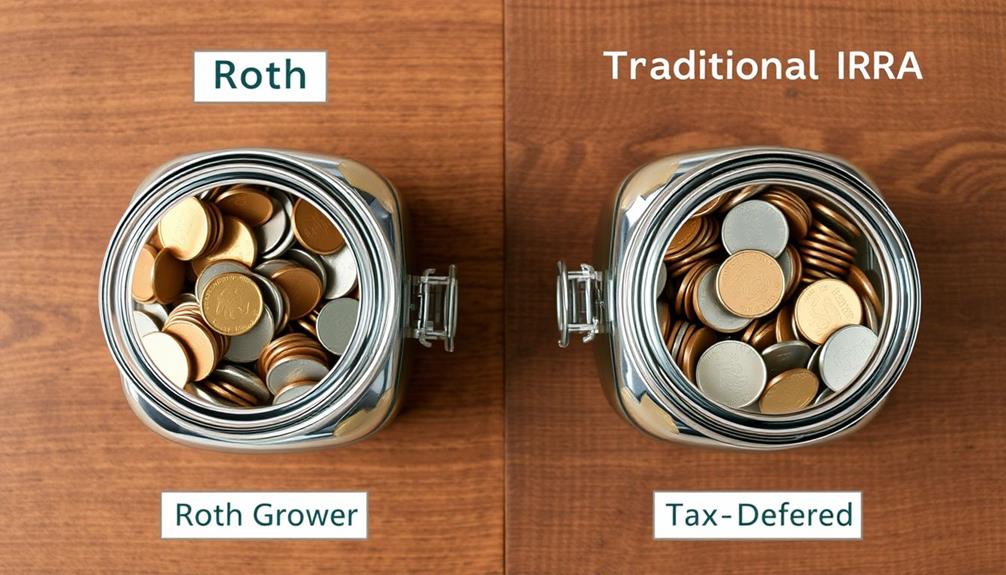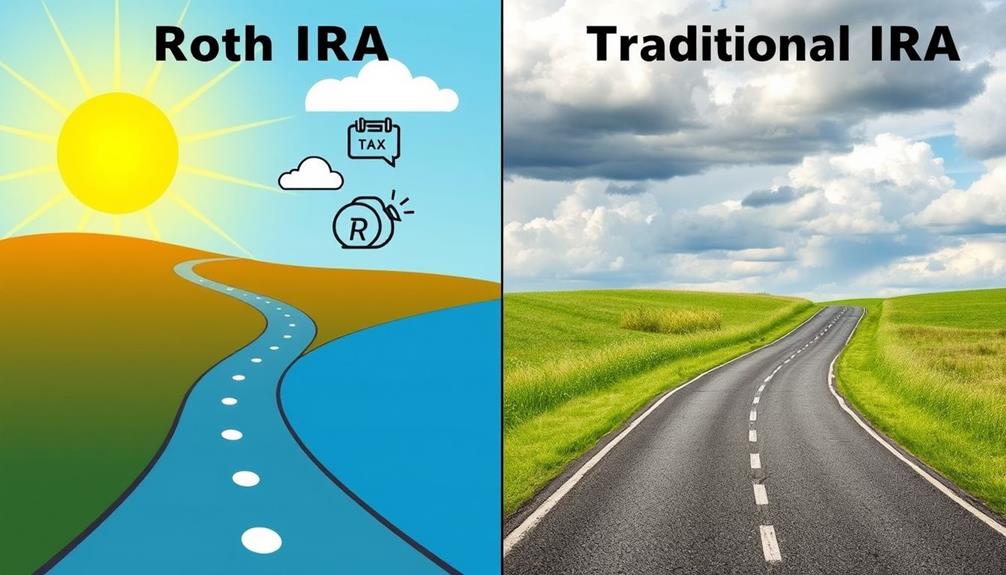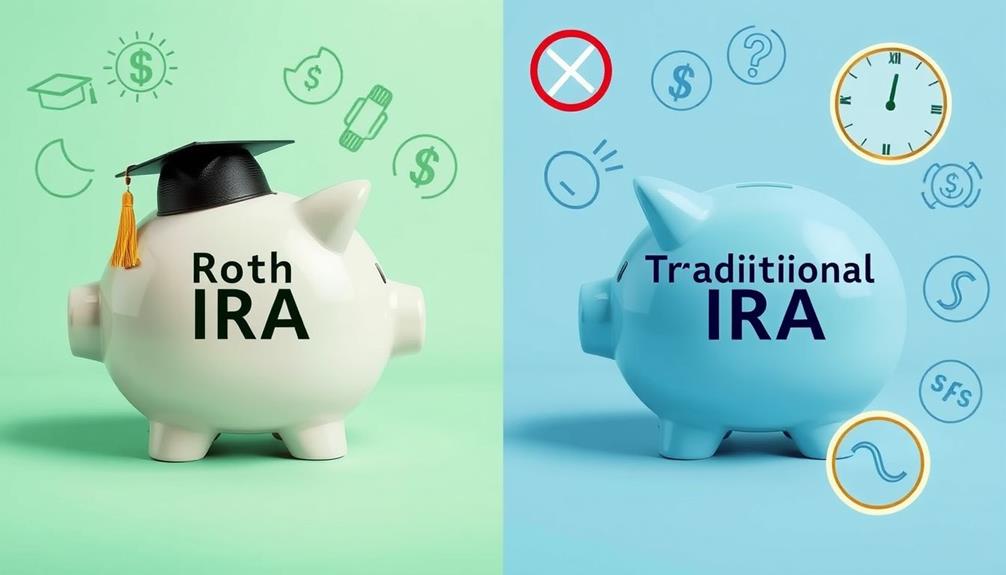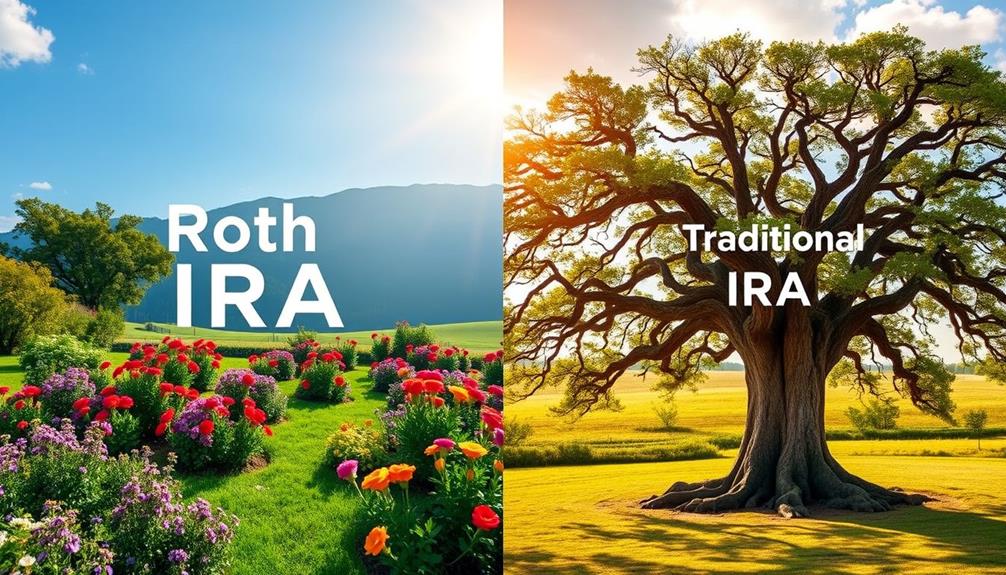Deciding between a **Roth IRA** and a **Traditional IRA** depends on your financial goals and anticipated tax situation. If you seek immediate **tax advantages** and predict being in a lower tax bracket during retirement, then a Traditional IRA may suit you. On the other hand, if you value **tax-free withdrawals** and desire flexibility with your contributions, a Roth IRA could be more suitable, especially if you expect to be in a higher tax bracket down the line. Take into account your income, tax consequences, and withdrawal requirements to make the optimal decision for your future. There is much more to consider regarding these accounts and the advantages they offer. Find out more about these retirement savings options to make an informed choice that benefits you in the long run.
Key Takeaways
- Consider your current tax rate versus expected retirement tax rate; Roth IRAs benefit those anticipating higher future taxes.
- Evaluate contribution limits and income restrictions; Traditional IRAs may offer more flexibility for high earners regarding contributions.
- Assess withdrawal needs; Roth IRAs provide tax-free access to contributions anytime, while Traditional IRAs have penalties for early withdrawals.
- Understand RMD rules; if you prefer not to take required minimum distributions, a Roth IRA is more suitable.
- Factor in your retirement timeline; Roth IRAs allow for tax-free growth over longer periods, benefiting those with more time until retirement.
Overview of IRAs

Individual Retirement Accounts (IRAs) serve as powerful tools for retirement savings, helping you set aside money for your future. There are two main types of IRAs: Traditional and Roth.
With a Traditional IRA, you make contributions using pre-tax dollars, which can provide immediate tax benefits, such as potential deductions on your taxes. This means you'll reduce your taxable income now, but you'll pay taxes on withdrawals during retirement. Additionally, you may consider diversifying your retirement portfolio with options like a Gold IRA, which can protect against inflation and market downturns diversification of retirement portfolio essential.
On the other hand, Roth IRAs are funded with after-tax dollars. This allows your investments to grow tax-free, and you can enjoy tax-free withdrawals in retirement, providing a significant advantage for your long-term financial planning.
However, it's crucial to understand that Roth IRAs do have income limits for contributions, while Traditional IRAs have no such restrictions, though deductibility may vary based on your income and any employer-sponsored retirement plans.
Additionally, Traditional IRAs require you to start taking required minimum distributions (RMDs) at age 73, whereas Roth IRAs don't have mandatory distributions during your lifetime. Understanding these features can help you make informed decisions about your retirement savings strategy.
Key Differences Between Roth and Traditional IRAs

When comparing Roth and Traditional IRAs, you'll notice key differences in tax treatment, contribution limits, and withdrawal flexibility.
Roth IRAs let you contribute after-tax dollars for tax-free withdrawals, while Traditional IRAs may offer tax deductions now but tax you later.
Additionally, Gold IRAs provide tax advantages that can complement your retirement strategy.
Understanding these distinctions can help you choose the right account for your retirement strategy.
Tax Treatment Comparison
Understanding the tax treatment of Roth and Traditional IRAs is vital for making informed retirement planning decisions. The way you handle contributions and withdrawals can greatly impact your financial goals.
Here's a quick comparison:
– Roth IRA contributions are made with after-tax dollars, allowing you to withdraw funds tax-free in retirement. This can be particularly beneficial if you anticipate being in a higher tax bracket during retirement.
Additionally, common financial terms associated with IRAs, such as "tax implications," are essential for understanding potential consequences of your choices.
- Traditional IRA contributions may be tax-deductible, but you'll pay income tax on withdrawals, which can affect your retirement income strategy.
- Roth IRAs don't require required minimum distributions (RMDs) during your lifetime, giving you more control over your funds.
- If you withdraw contributions from a Roth IRA early, you won't face an early withdrawal penalty, unlike with a Traditional IRA, which imposes a 10% penalty on early withdrawals before age 59½ unless exceptions apply.
Contribution Limits Explained
Steering the contribution limits for Roth and Traditional IRAs can greatly influence your retirement savings strategy. For 2023, you can contribute up to $6,500 across both retirement accounts, with an increase to $7,000 in 2024. If you're aged 50 or older, you can take advantage of an additional $1,000 catch-up contribution.
When it comes to Roth IRAs, your ability to contribute is subject to income limits. For single filers, contributions phase out for those with a modified adjusted gross income (MAGI) over $138,000.
In contrast, Traditional IRAs have no income limits for contributions; however, your income can impact tax deductibility. For instance, full deductibility phases out for single filers earning over $73,000 and married couples filing jointly at $116,000.
It's essential to understand that while Roth IRA contributions are made with after-tax dollars, Traditional IRA contributions might offer a tax break now if they're deductible.
These nuances will help you align your contributions with your financial goals, ensuring you maximize your retirement savings potential.
Withdrawal Flexibility Options
One major difference between Roth and Traditional IRAs is how and when you can access your funds. With a Roth IRA, you enjoy greater withdrawal flexibility, allowing you to access your contributions penalty-free at any time.
However, early withdrawals of earnings may incur taxes and penalties unless specific conditions are met. In contrast, Traditional IRAs impose a 10% penalty on early withdrawals before age 59½, with exceptions for situations like disability or certain medical expenses.
Here are some key points to reflect on:
- Roth IRA: Tax-free withdrawals in retirement, provided the account has been open for at least five years.
- Traditional IRA: Withdrawals are taxed as ordinary income and may incur penalties if taken early.
- RMDs: Required Minimum Distributions must begin at age 73 for Traditional IRAs, while Roth IRAs have no RMDs during your lifetime.
- Financial Goals: Roth IRAs offer more flexibility for accessing your contributions, aligning better with certain financial goals.
Understanding these withdrawal options can greatly influence your retirement planning strategy. Choose wisely based on your needs!
Contribution Limits and Income Restrictions

When you're considering a Roth or Traditional IRA, understanding the contribution limits and income restrictions is essential.
For 2024, you can contribute a combined total of $7,000, but certain income thresholds might affect your ability to contribute fully to a Roth IRA.
Additionally, while Traditional IRA contributions aren't limited by income, the deductibility of those contributions can phase out based on your earnings.
Annual Contribution Limits
Understanding the annual contribution limits for Roth and Traditional IRAs is essential for effective retirement planning. For 2023, you can contribute up to $6,500 to either account, with an increase to $7,000 if you're 50 or older.
Keep in mind the following key points:
- Roth IRA contributions phase out for single filers starting at a modified adjusted gross income (MAGI) of $138,000.
- Traditional IRA contributions can be fully deductible for single filers with incomes up to $73,000.
- Married couples filing jointly can deduct contributions up to $116,000 for the same year.
- Combined contributions to both IRAs can't exceed the annual contribution limits.
Understanding these contribution limits helps you align your retirement savings strategy with your financial goals.
While there are no income limits for contributing to a Traditional IRA, your ability to claim a tax deduction may change based on your income and participation in employer-sponsored plans.
Make sure to monitor your contributions to optimize your tax benefits and maximize your retirement savings.
Income Phase-Out Thresholds
Income phase-out thresholds play an essential role in determining your eligibility to contribute to Roth and Traditional IRAs. For the tax year 2024, if you're a single filer, you can contribute to a Roth IRA only if your modified adjusted gross income (MAGI) is below $161,000; contributions phase out completely at $176,000.
For married couples filing jointly, the combined MAGI limit is $240,000, phasing out entirely at $250,000.
When it comes to Traditional IRAs, there are no income limits on contributions. However, if you want to deduct contributions on your tax return, the income phase-out thresholds apply.
For single filers, the ability to deduct contributions phases out between MAGI of $73,000 and $83,000. For married couples filing jointly, the phase-out range is $116,000 to $136,000.
If you're aged 50 or older, you can make catch-up contributions of an additional $1,000, allowing you to increase your annual limit for both Roth and Traditional IRAs to $8,000.
Understanding these thresholds helps you plan effectively for your retirement savings.
Deductibility Based on Income
Determining how much you can deduct for Traditional IRA contributions largely depends on your income level and whether you're covered by a workplace retirement plan. For the tax year 2024, the contribution limit for both Roth and Traditional IRAs is $7,000, or $8,000 if you're 50 or older.
Here's how income affects deductibility:
- If you're a single filer covered by a workplace plan, you can fully deduct contributions if your income is $77,000 or less.
- Married couples filing jointly can deduct contributions if their MAGI is below $236,000.
- Roth IRA contributions begin to phase out at $161,000 for single filers and $240,000 for married couples.
- There's no age limit for contributing to Roth IRAs, while Traditional IRA contributions are only allowed until age 70½.
These factors are essential for aligning your retirement strategy with your financial goals. Understanding the income restrictions and deductibility can help you decide if a Roth IRA or Traditional IRA is the better choice for your tax situation and retirement planning.
Tax Implications and Benefits

How do the tax implications of Roth and Traditional IRAs affect your retirement strategy? When considering Roth IRA vs. Traditional IRA, the differences in tax treatment can considerably influence your financial planning.
With a Traditional IRA, you can enjoy immediate tax breaks since contributions are often tax-deductible, lowering your taxable income today. However, remember that withdrawals during retirement are taxed as ordinary income, which could lead to a larger tax burden if you're in a higher tax bracket.
On the other hand, Roth IRAs are funded with after-tax money, allowing for tax-free withdrawals in retirement. This feature is particularly advantageous if you expect your tax rate to increase over time.
Additionally, Roth IRAs don't have required minimum distributions (RMDs) during your lifetime, giving you more flexibility in retirement planning. If you need access to funds, Roth IRAs allow for penalty-free withdrawals of contributions at any time, whereas early withdrawals from Traditional IRAs incur a 10% penalty and taxes.
Ultimately, weighing these tax implications can help you choose the right account to align with your financial goals.
Withdrawal Rules and Penalties

When it comes to accessing your retirement savings, understanding the withdrawal rules and penalties for Roth and Traditional IRAs can make a significant difference. Here's what you need to know:
- Roth IRA: You can withdraw your contributions at any time without penalties. However, earnings can only be withdrawn tax-free after a five-year holding period and once you reach age 59½.
- Traditional IRA: Early withdrawals before age 59½ incur a 10% penalty, plus income tax, unless exceptions apply (e.g., disability, first-time home purchase).
- Required Minimum Distributions (RMDs): Traditional IRAs require RMDs starting at age 73, while Roth IRAs don't have RMDs during your lifetime.
- Early Withdrawal Penalties: If you fail to take your RMD from a Traditional IRA, you'll face a hefty 25% penalty on the amount you should have withdrawn.
Given these rules, a Roth IRA is often more flexible for accessing funds before retirement. You can enjoy penalty-free withdrawals of contributions, while the tax implications of Traditional IRAs can be more complex.
Understanding these differences is essential for making the best choice for your financial goals.
Evaluating Future Tax Rates

Understanding the implications of future tax rates is essential when choosing between a Roth and a Traditional IRA. If you anticipate being in a higher tax bracket during retirement, Roth IRAs might be the better option since they're funded with after-tax dollars. This means your contributions grow tax-free, and you won't pay taxes on withdrawals.
On the other hand, if you expect to be in a lower tax bracket, a Traditional IRA could be advantageous. With pre-tax contributions, you reduce your taxable income now, but you'll owe taxes on withdrawals later.
Consider potential income increases or changes in tax laws that could impact your long-term tax savings. Additionally, income limits for Roth IRA contributions—like the $161,000 for single filers in 2024—may affect your eligibility, making it vital to evaluate your current and future income levels.
Also, think about how Social Security benefits and other retirement income will be taxed. This understanding can help you gauge your overall tax liability in retirement, guiding you toward the IRA that best aligns with your financial goals.
Frequently Asked Questions
Is It Better to Put Money Into Roth or Traditional Ira?
When deciding whether to invest in a Roth or Traditional IRA, consider your current tax rate and future expectations. If you think taxes will rise, a Roth may benefit you more in the long run.
Is a Roth IRA Better Than a Traditional Savings Account?
A Roth IRA's tax-free growth and flexible withdrawals make it a better choice for long-term savings compared to a traditional savings account. You'll enjoy more control over your funds and potential for greater returns.
Should My Retirement Be Roth or Traditional?
Choosing between a Roth or Traditional IRA depends on your current and future tax situation. If you expect higher taxes later, a Roth might suit you. If lower taxes seem likely, a Traditional could be better.
Why Is a Roth IRA Better Than a Regular Investment Account?
A Roth IRA's tax-free growth and withdrawals give you more financial freedom in retirement. You can access your contributions anytime without penalties, plus your beneficiaries inherit it tax-free, unlike regular investment accounts.
Conclusion
Choosing between a Roth and Traditional IRA is like picking a path through a dense forest. Each trail leads to a different destination, shaped by your financial goals and future tax expectations. If you value tax-free growth and plan to climb higher in income, the Roth might be your sunny route. But if you prefer immediate tax breaks to pave your way, the Traditional could be your sturdy path. Ultimately, trust your instincts and choose the trail that resonates with your journey.










